We may earn revenue from the products available on this page and participate in affiliate programs. Learn More ›
If you identify as a traditional backpacker, then you likely aren’t afraid of a heavy backpack. After all, when a backpack is well-built and comfortable then you’ll barely notice the addition of a few pounds on your shoulders. If that sounds like you, then this review of the Mystery Ranch Bridger 65 is one to look at. Despite being the heaviest backpack we’ve tested yet, it won our highest marks for comfort. It also had several features that changed the way our testers looked at packing their bag for and during a trek.
Before we jump into the review, it’s worth noting a few things about Mystery Ranch. One of its founders is Dana Gleason, whose first company was Dana Designs. Dana Designs was a renowned backpack maker and those packs—some of which are from the 1980s—can still be found on trails today. After selling Dana Designs, Dana Gleason started Mystery Ranch with Renée Sippel-Baker in 2000. They gained a following among military and wildland firefighters, and their backpacking line has begun to pick up steam in recent years.
Several of our testers noted that they were particularly excited to try this pack (one of them uses an old Dana Designs Terraplane when she isn’t testing for us). We had high expectations going into this test (to match the higher price tag of this backpack). Let’s see how it did.
- Capacity: 63 liters
- Weight: 5.5 pounds
- Unisex Torso Fit: 15 to 24 inches
- Women’s Torso Fit: 14 to 22 inches
- Fabric: 100D Robic nylon ripstop with 330D Robic nylon in certain spots
- Frame: Spring steel
- Pockets: Removable top lid pocket with inner mesh pocket, two side stretch pockets, front pocket (not mesh) with two inner mesh pockets, two hip belt zip pockets, two shoulder strap pockets
- Adjustment Points: Attached hip belt, shoulder straps, load lifters, adjustable back panel, two sternum straps
- Bladder Compatible: Yes
- Bear Can Compatible: Yes, vertical only (tested with a Bear Vault 500)
- Comfortable up to 42 pounds (as reported by the testers)
| Body Type | Size | Capacity* | Weight* | Torso Fit Range |
| Bridger 65 (unisex) | Small | 63 liters | 5.5 pounds | 15 to 20 inches |
| Medium | 63 liters | 5.5 pounds | 15 to 20 inches | |
| Large | 63 liters | 5.5 pounds | 17 to 24 inches | |
| Extra Large | 63 liters | 5.5 pounds | 17 to 24 inches | |
| Bridger 65 (women’s fit) | Extra small | 63 liters | 5.5 pounds | 13 to 18 inches |
| Small | 63 liters | 5.5 pounds | 13 to 18 inches | |
| Medium | 63 liters | 5.5 pounds | 16 to 22 inches | |
| Large | 63 liters | 5.5 pounds | 16 to 22 inches |
*Mystery Ranch did not supply specifics on the difference in weights between the different sizes for this review
At first glance, what’s most noticeable about the Mystery Ranch Bridger 65 is its lack of a mesh stuff-it pocket on the back of the pack. That’s your first hint that this backpack is taking a wholly different approach to organization than other top backpacking backpacks. The Bridger 65 has pockets in places that other backpacking backpacks do not (like the shoulder straps) while skipping other common pockets, including the pocket underneath the brain. Opening up the backpack reveals even more secret organizational features.
But what really impressed our testers with the Mystery Ranch Bridger 65 was how easy it was to get that just-right fit.
About This Backpack Test
With plenty of backpacking gear, it’s possible to quantify what the “best” products are in any category. The best backpacking water filters need to be able to perform reliably across a wide variety of water sources. The best tent stakes need to have great holding power at a low weight. The best bear cans need to be able to keep bears out of your food. But what makes for the best backpacking backpack is more subjective.
First you have to consider everything you are carrying: a 20-pound overnight load carries a lot differently than 40 pounds of gear for a weeklong trip. Then there is how you pack that gear into your pack—do you use a water bladder or Nalgenes? Are you carrying lots of layers that you’ll need easy access to, or are you hiking in a fair-weather climate? But the biggest X factor of all is you: the padding, hip belt length, torso width, and shoulder strap curve all vary between backpacks, and choosing a backpack that’s wrong for your frame can result in everything from back pain to bruising.
To help find the best backpacking backpack for each body type, we selected a panel of testers across a wide range of body types and experiences, who will test a series of backpacks throughout the year. Once all bags are tested we’ll pool the results into a best backpacking backpacks article.
Our Testers
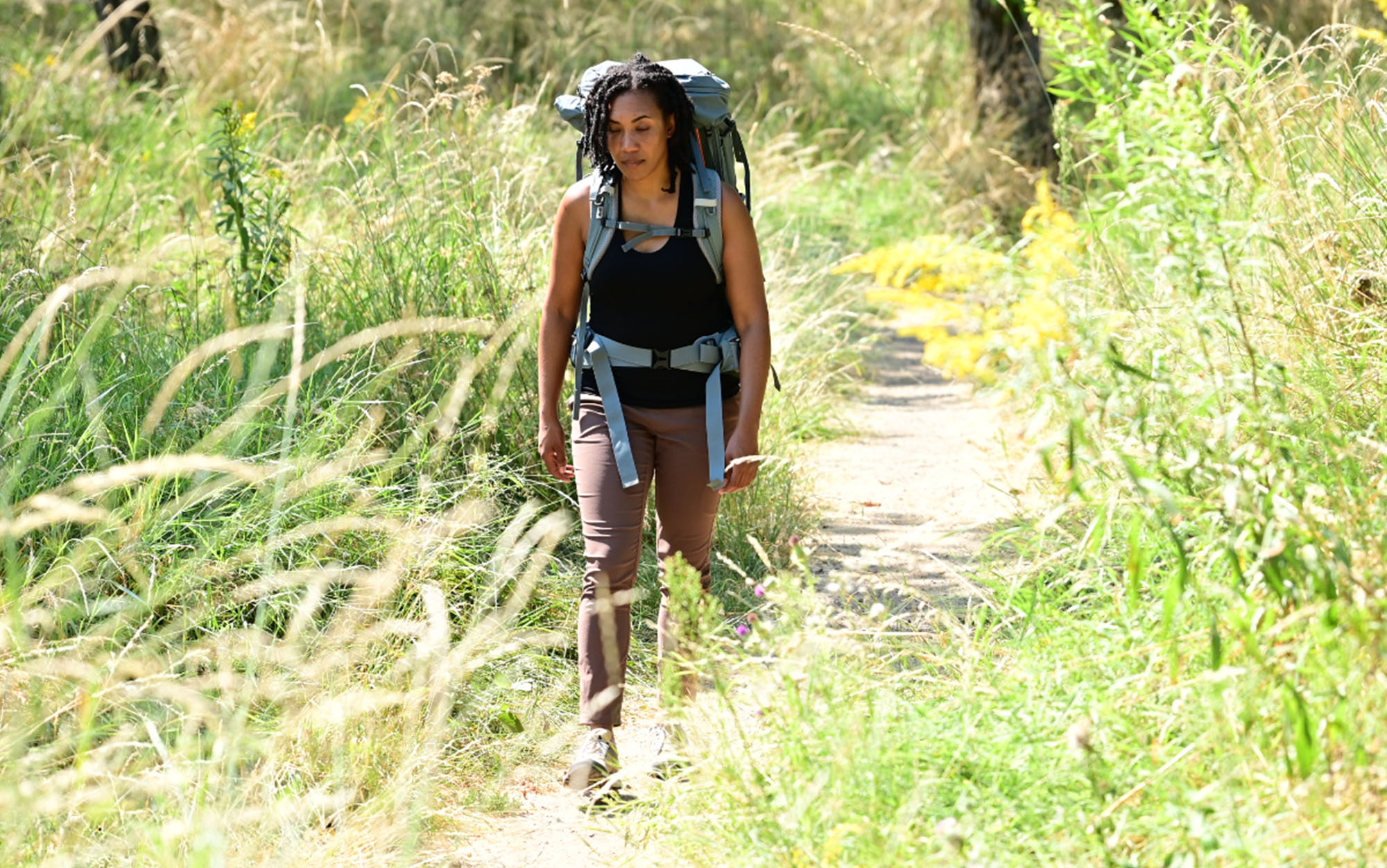
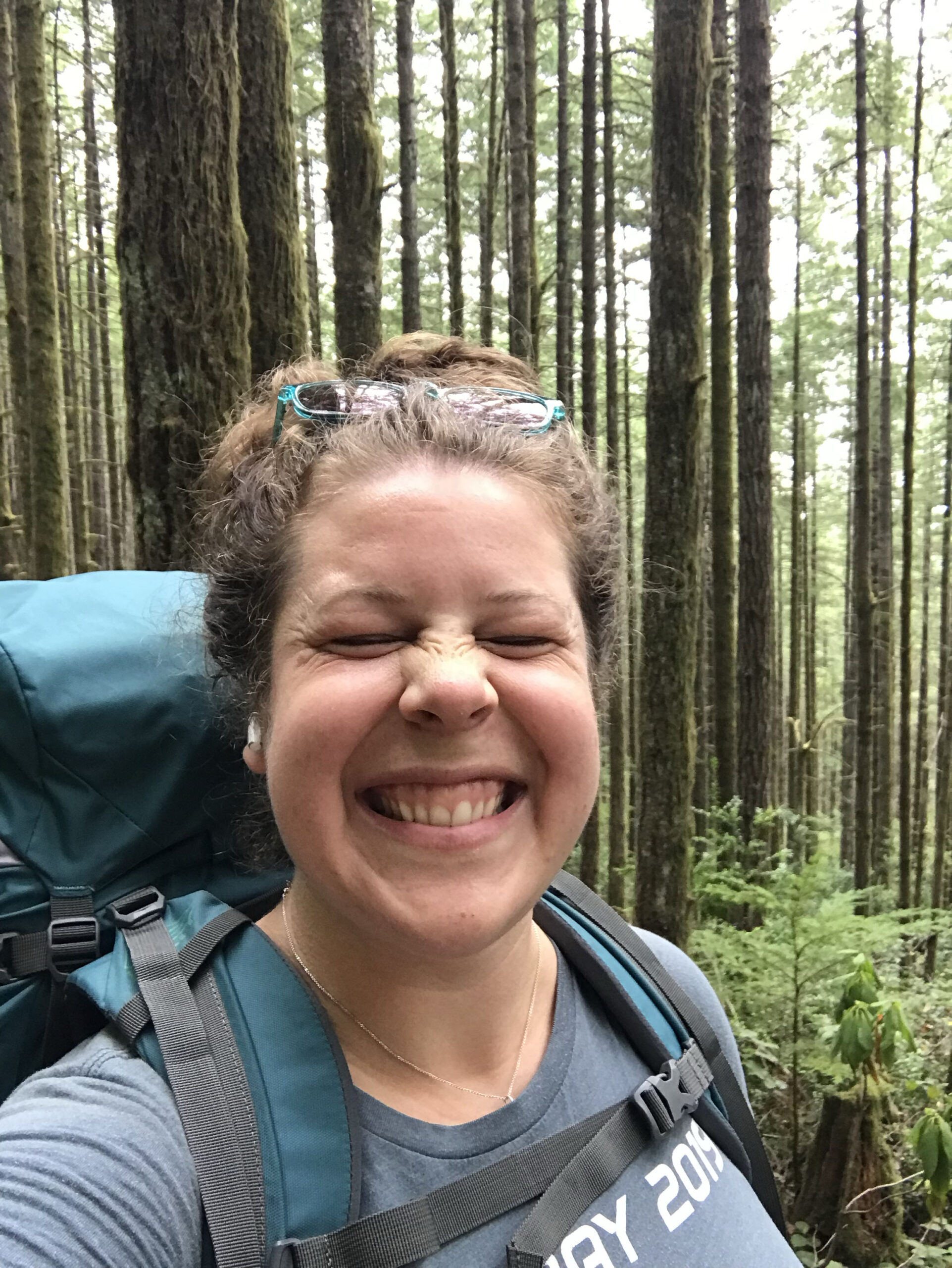
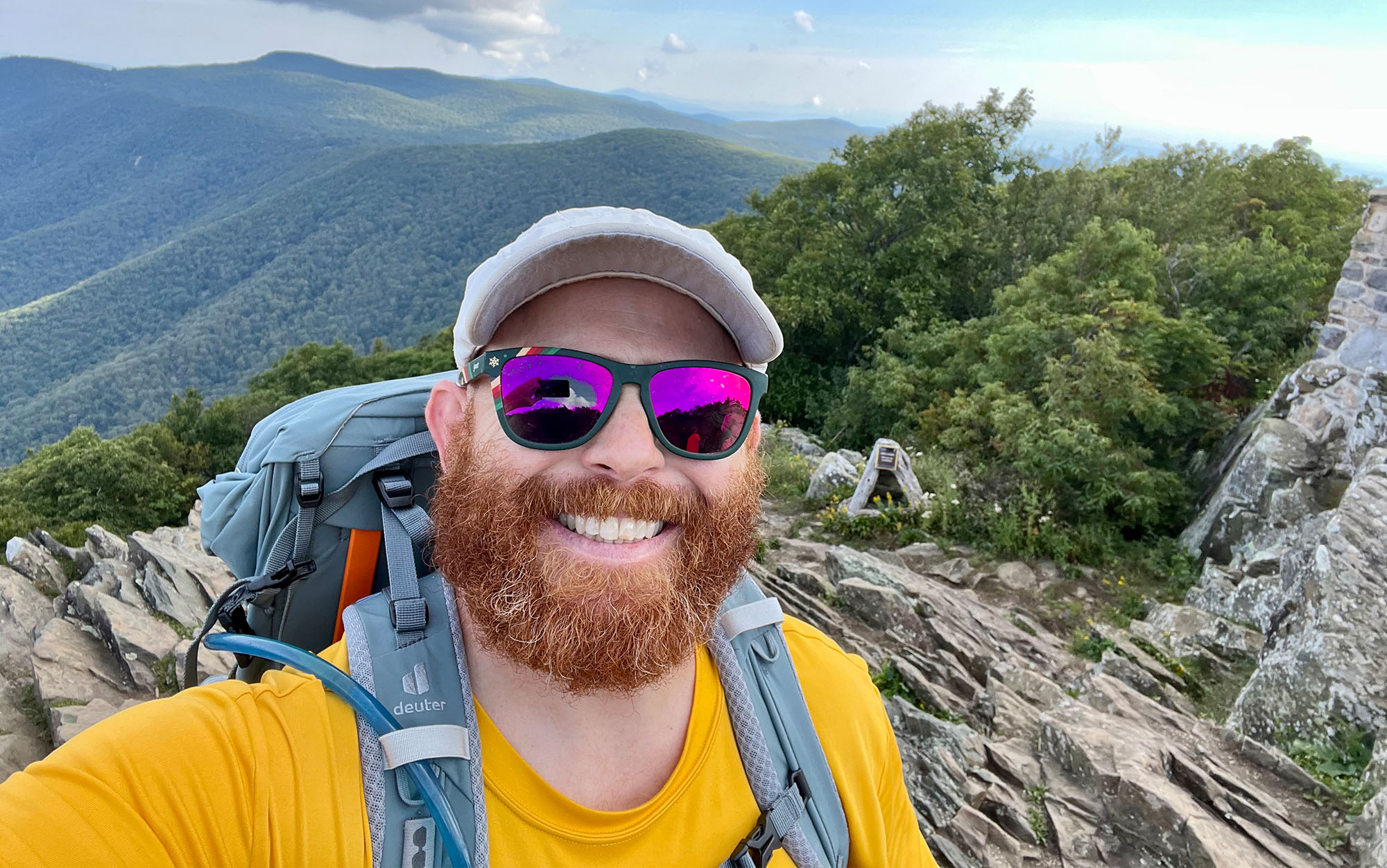
Rebecca Ross is a backpacker, climber, mountaineer, and runner who is a staff writer for GearJunkie and has contributed to Climbing magazine, and Melanin Base Camp.
Diana Helmuth has hiked extensively throughout the western U.S., Europe, and Chile and is the author of How to Suffer Outside, which won a National Outdoor Book Award.
Jason Boyle has been backpacking, hiking, and trail running for 30 years and currently works as a guide for REI out of Shenandoah National Park.
Testing the Mystery Ranch Bridger in the Field
It’s rare for a backpack to receive such universally high marks from this group of testers in every category—except value. This is by far the most expensive backpacking backpack we’ve looked at, over a hundred dollars more than mainstays like the Deuter Aircontact and Gregory Baltoro and Deva.
| Category | Rebecca | Diana | Jason | Average |
| Fit: Could you adjust it to your satisfaction? | 9 | 10 | 8 | 9 |
| Comfort: Did the pack cause you any pain or discomfort? | 8 | 10 | 8 | 8.7 |
| Load Bearing: How did it handle a heavy load? | 10 | 10 | 8 | 9.3 |
| Storage: Did the pack adequately hold all your gear? | 10 | 8 | 7 | 8.3 |
| Accessibility: How easy was it to access all your gear in the field? | 7 | 8 | 7 | 7.3 |
| Value: Is it worth the money? | 6 | 5 | 7 | 6 |
| Overall | 9 | 8.5 | 8 | 8.5 |
Let’s dig into whether what our testers loved about the Mystery Ranch Bridger 65 makes it worth its high price tag.
Fit, Comfort, and Load Bearing
The first thing that two of our testers noticed was the backpack’s weight—one of them stuck it in on a home scale and reported that it came out to over six pounds. That makes the Mystery Ranch Bridger 65 not only the heaviest backpacking backpack in our test, but also one of the heaviest backpacking backpacks on the market.

While that alone would be a dealbreaker for lightweight backpackers, our testers (who identify as traditional backpackers) found that the Mystery Ranch Bridger 65’s extra weight was offset by its load bearing ability and overall comfort. All three testers reported that they were able to balance some of their heaviest loads in this test comfortably with our smallest tester, Rebecca, commenting that, “Once it was on my back, it actually seemed lighter than when it was being picked up.”
All three testers were further impressed with how easy it was to adjust the Mystery Ranch Bridger 65 to fit their body types. The one exception to that was with the back panel—a notoriously tricky adjustment point for all the backpacking backpacks in this test. The adjustable back panel of the Bridger 65 relies on Velcro, similar to the Gregory Baltoro and Deva and Kelty Coyote.
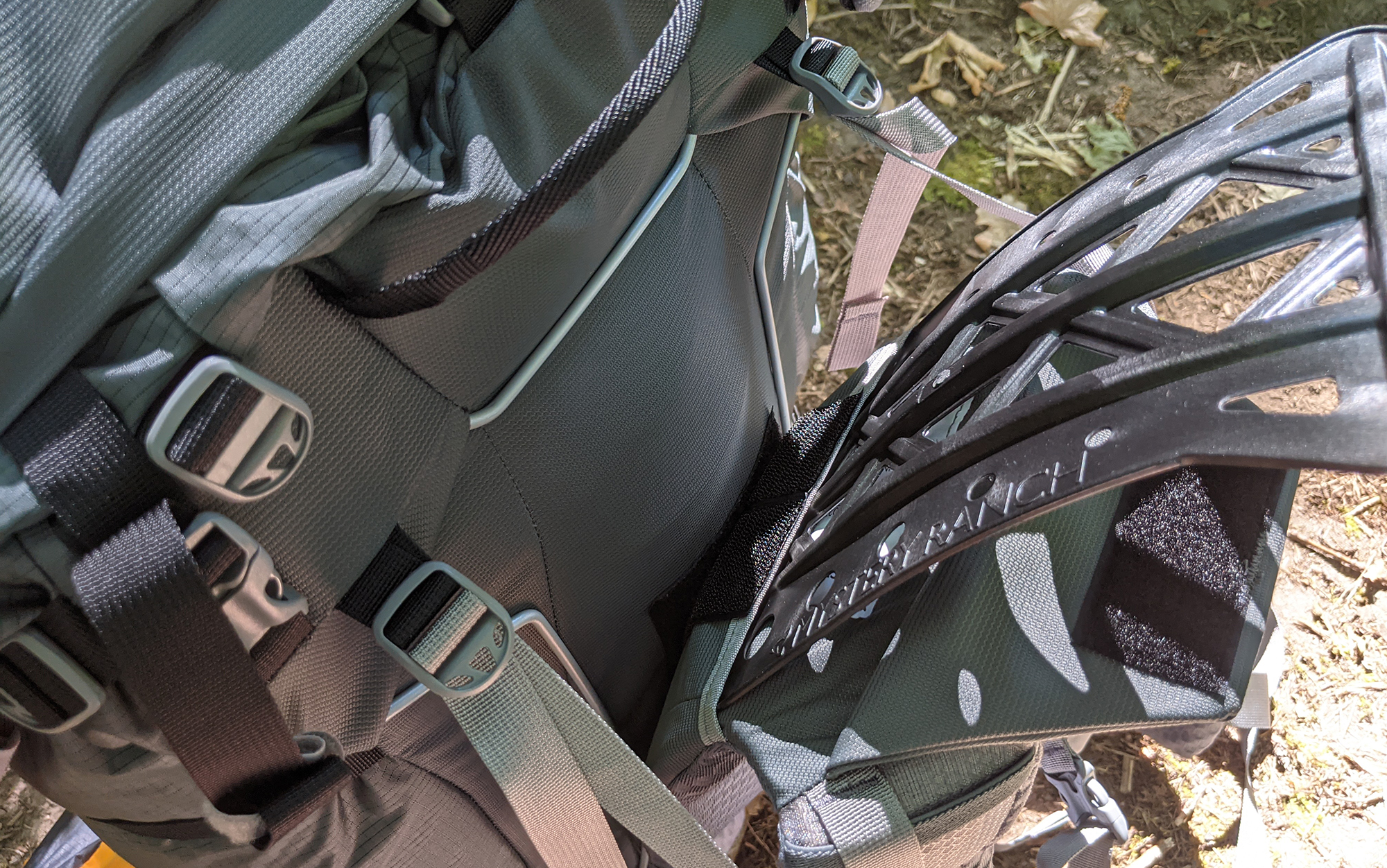
To detach, you pull out a plastic tool hidden in the back panel and use it to break the Velcro connection. Then you can pull the panel up or down to match the length of your torso. A key difference with this backpack compared to others that use a Velcro panel is the inclusion of metal sliders along the side. These help you adjust the backpack evenly on both sides, but don’t guarantee it. While none of the testers reported issues with the adjustable back panel in the field, Diana reported that she could “hear [the Velcro] every time I took the pack on and off.”
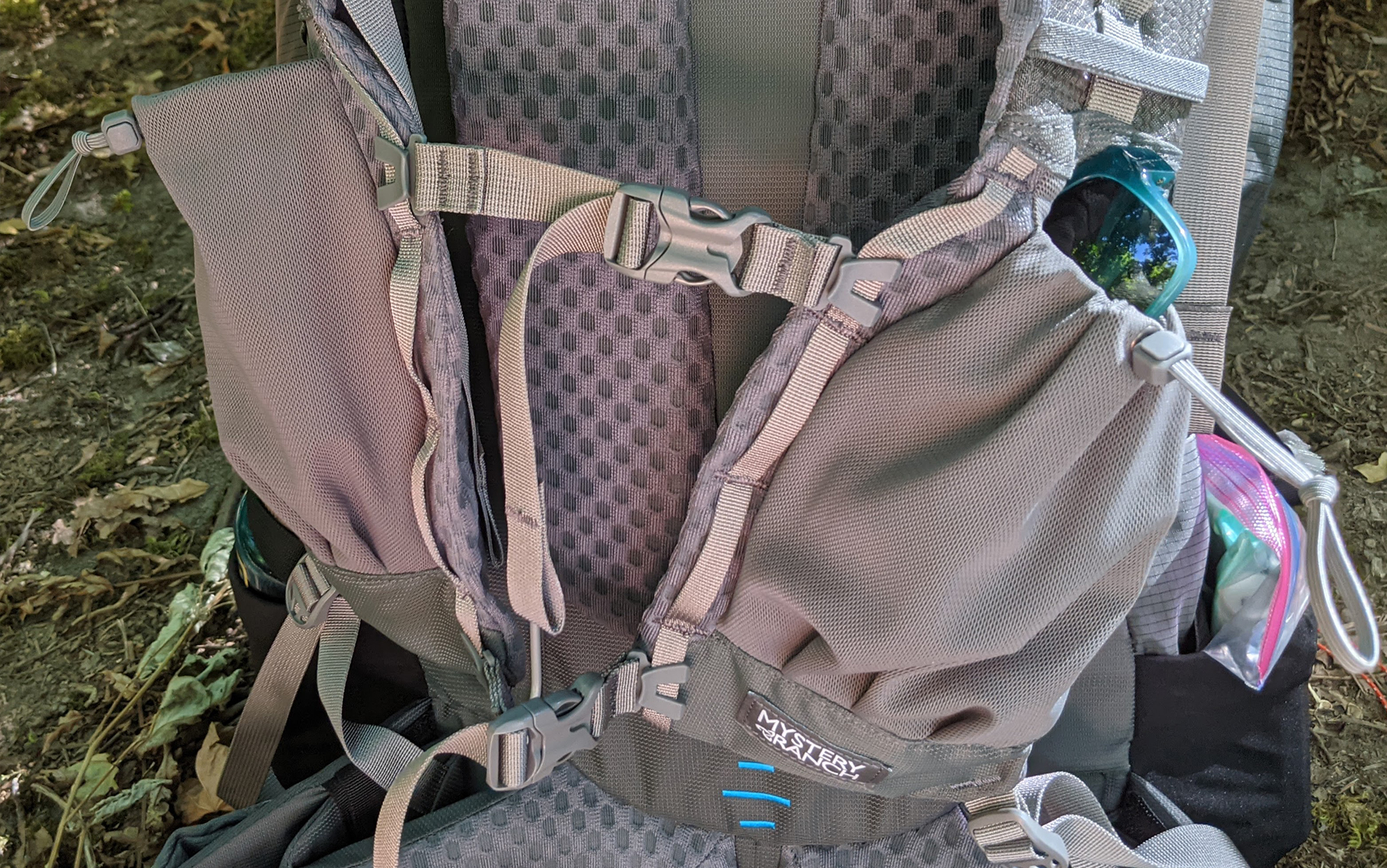
The Mystery Ranch Bridger 65 has all the other usual adjustment points for backpacking backpacks—hip belt, shoulder strap, load lifters, sternum strap—with a few extras. Instead of having one sternum strap, the Bridger 65 has two. This helps give backpackers greater control over the fit of their backpack. When you close up and tighten down both sternum straps it helps to keep the pack close against your body, while if you loosen up or release one it opens up your arm movements. Jason said that he appreciated being able to loosen and tighten the top buckle “depending if I was going uphill or downhill.” The Bridger 65 also included a second connection point for the load lifter straps, which can help users of different heights find the correct angle—essential for reducing pull against the shoulders and clavicle.

The hip belt on the Mystery Ranch Bridger 65 was one of the most cushioned in this series, but for one tester, Rebecca, it did not stay tight while she was backpacking along the Oregon Coast. That meant she had to pause and tighten it as she hiked, a minor annoyance. That being said, she still found the backpack exceptionally comfortable, even while carrying 33 pounds. Jason, who was carrying 42 pounds along The Wild Oak Trail in central Virginia, also reported some minor hip pain after the first day that dissipated over the course of his trip. All testers gave this backpack high marks for comfort.
Durability
There were a few notes on durability after the testing period. The first was that Diana had both elastic pole loops break during testing, the first while she was packing before her trip, the second while in the field.
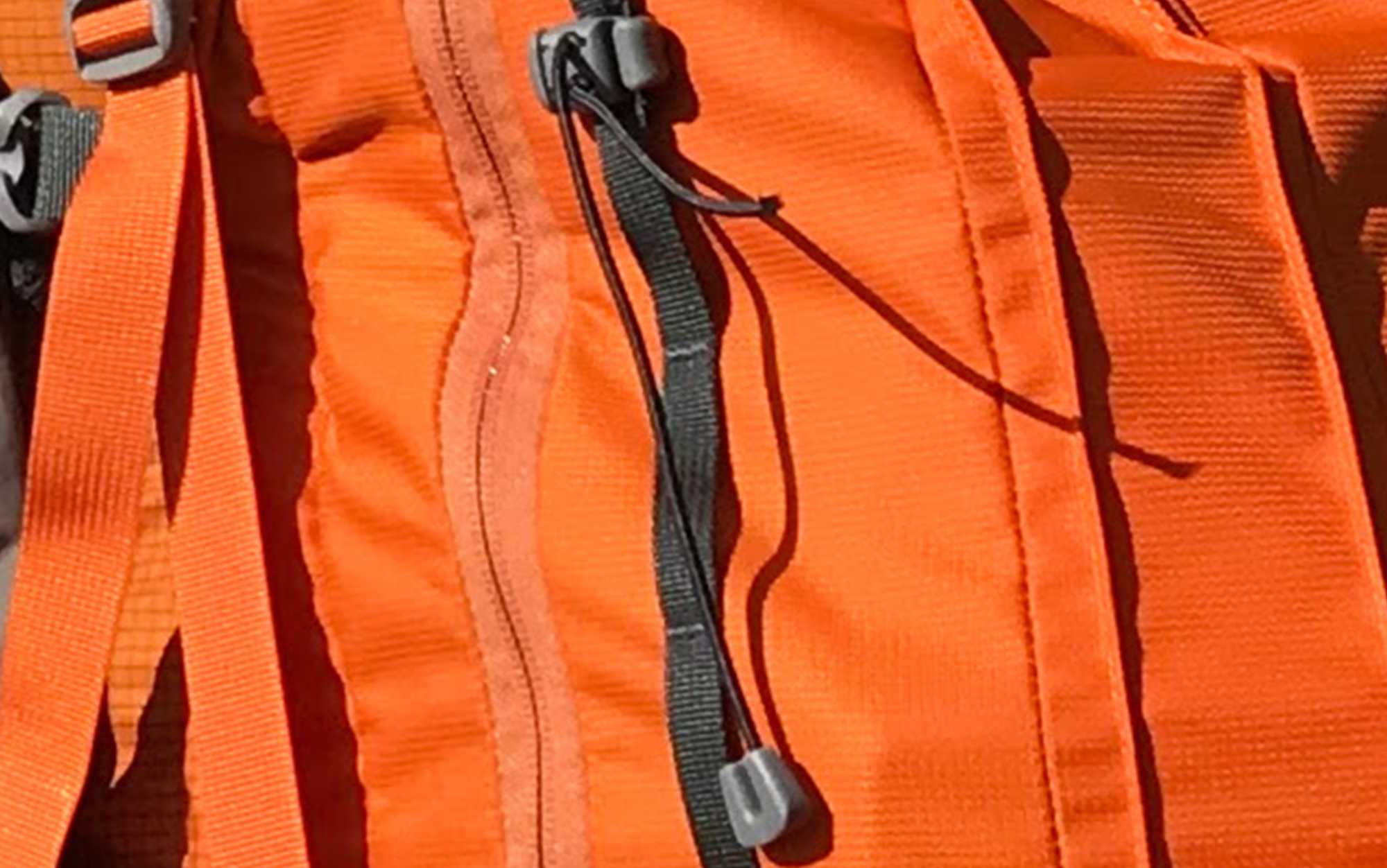
Other testers noted that the choice to use 100D Robic ripstop nylon on the front pocket means that it will likely last longer than those that use the more typical mesh.
Storage and Accessibility
While the testers ultimately liked the storage and accessibility of the Mystery Ranch Bridger 65, they reported that it took some getting used to. As noted above, this model includes a number of pockets not seen on other traditional backpacking backpacks and is missing a few of the more typical ones. One feature that escaped testers was a hidden buckle on the underside of the detachable brain. This allows you to convert it into a lumbar or waist pack if you intend to day hike from your campsite.
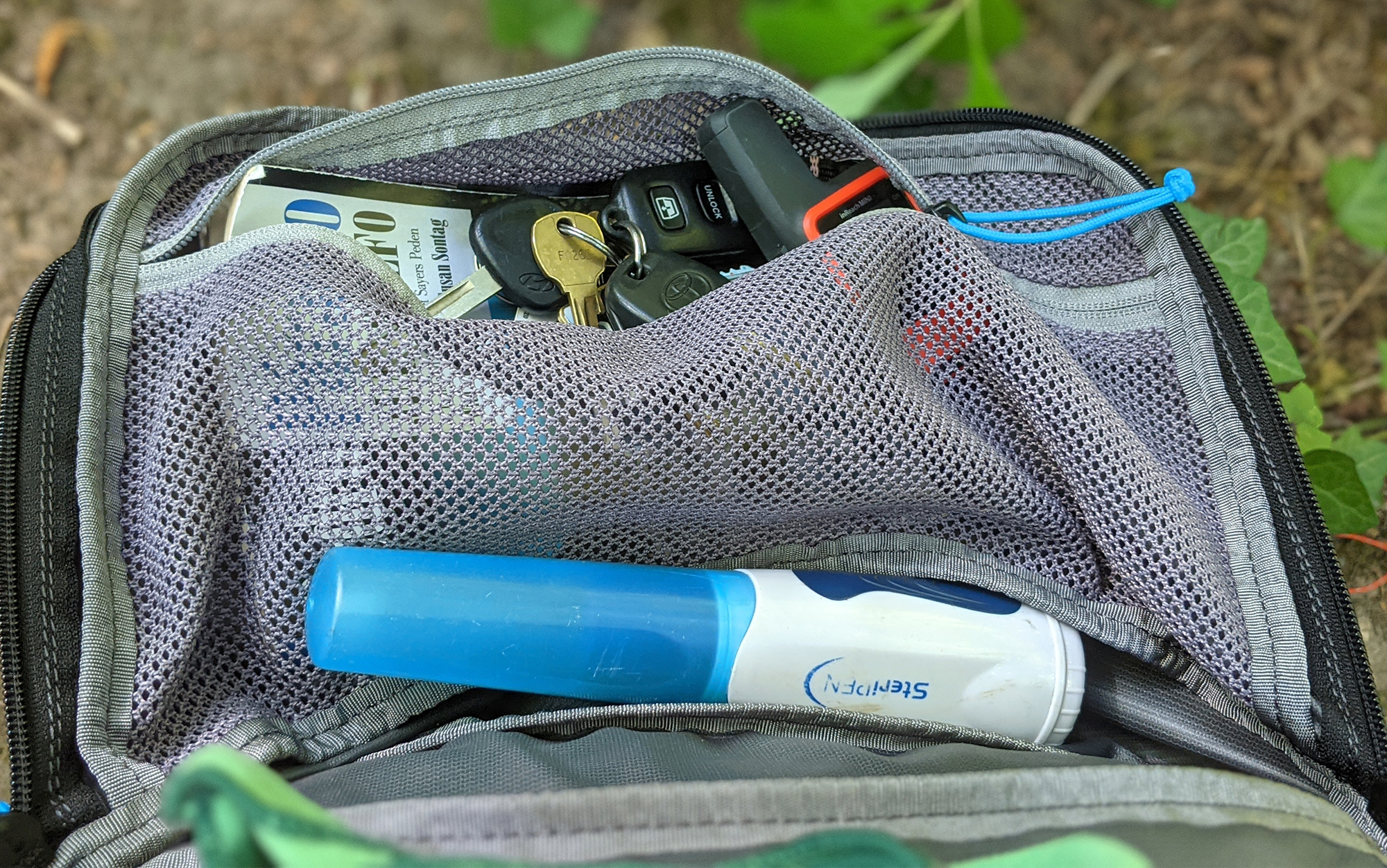
Their biggest rave was for the two mesh pockets on the shoulder straps. While this type of pocket is most commonly associated with running vests, it is becoming increasingly common on the best ultralight backpacks. All three testers were converted to this feature. They used them for everything from snacks to sunglasses to phones, and felt that the drawstring closure was plenty of security. The Mystery Ranch Bridger 65 doesn’t skimp on hip belt pockets either, meaning that testers were able to keep essentially double the small items at the ready than they were with other backpacking backpacks in this series. Diana noted that unlike other backpacking backpacks, she had an easy time zipping and unzipping the hip belt pockets while wearing the pack.
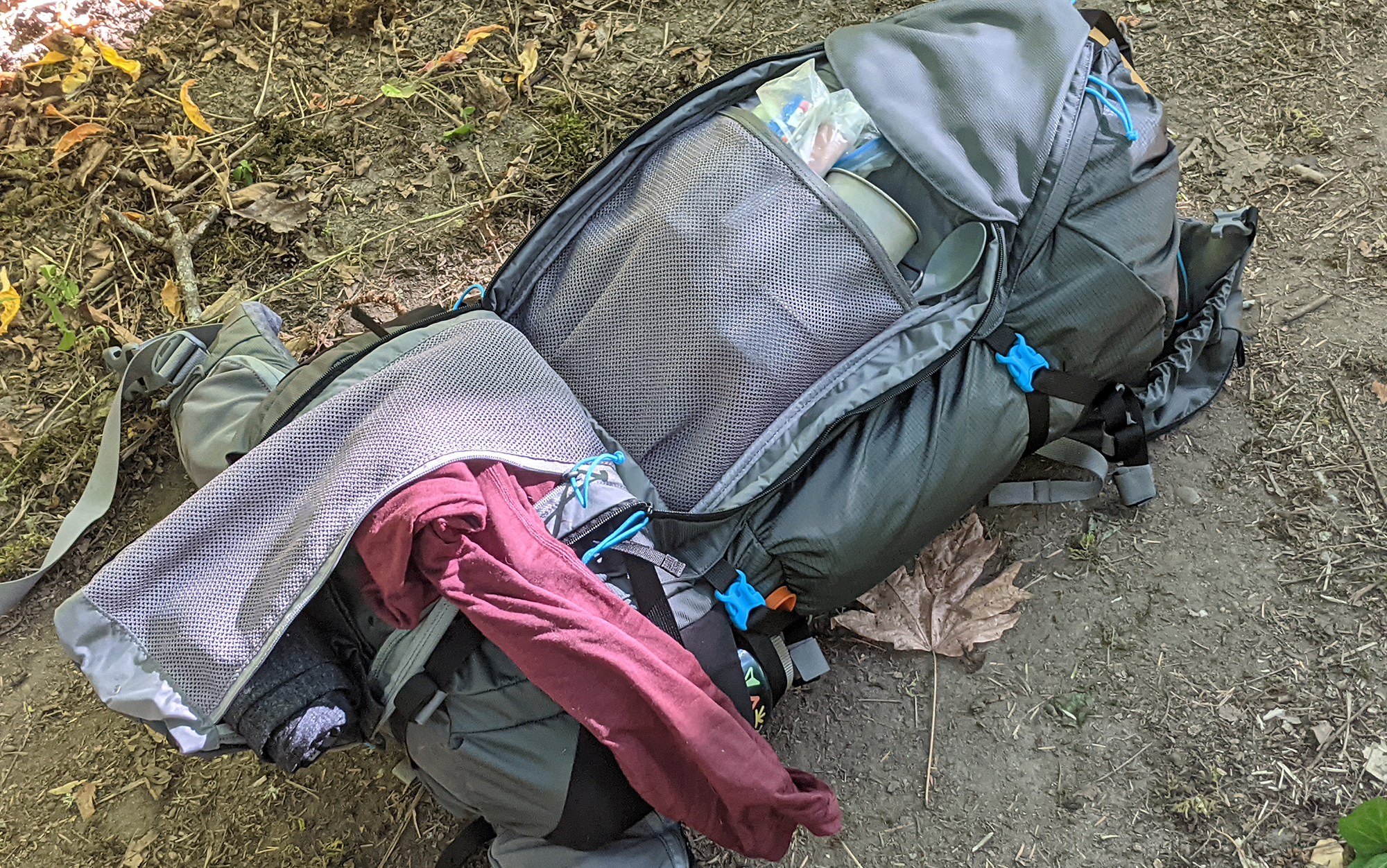
Another set of pockets that changed how our testers approached organizing their gear in their backpacks were the inner mesh pockets. The first set of these is inside the front zip pocket, with Jason noting that he “could put most of the same stuff I carry in a shove it pocket in the outside zippered pocket instead,” including his stove, cup, filter, and fuel canisters. Unlike a more traditional outside mesh pocket, it did take up space inside of the main compartment when filled to capacity.
Rebecca commented that the organization potential of these pockets could replace the need for separate stuff sacks on a trek. Complementing the hidden mesh pockets of the front pocket, there were an additional two mesh pockets on the interior of the backpack. These were located along the sides of the backpack, rather than on the front pocket. Jason experimented with keeping his sleeping pad and a magazine in one and a rain jacket in another, commenting that it had the potential to change how you organize your backpack if used.
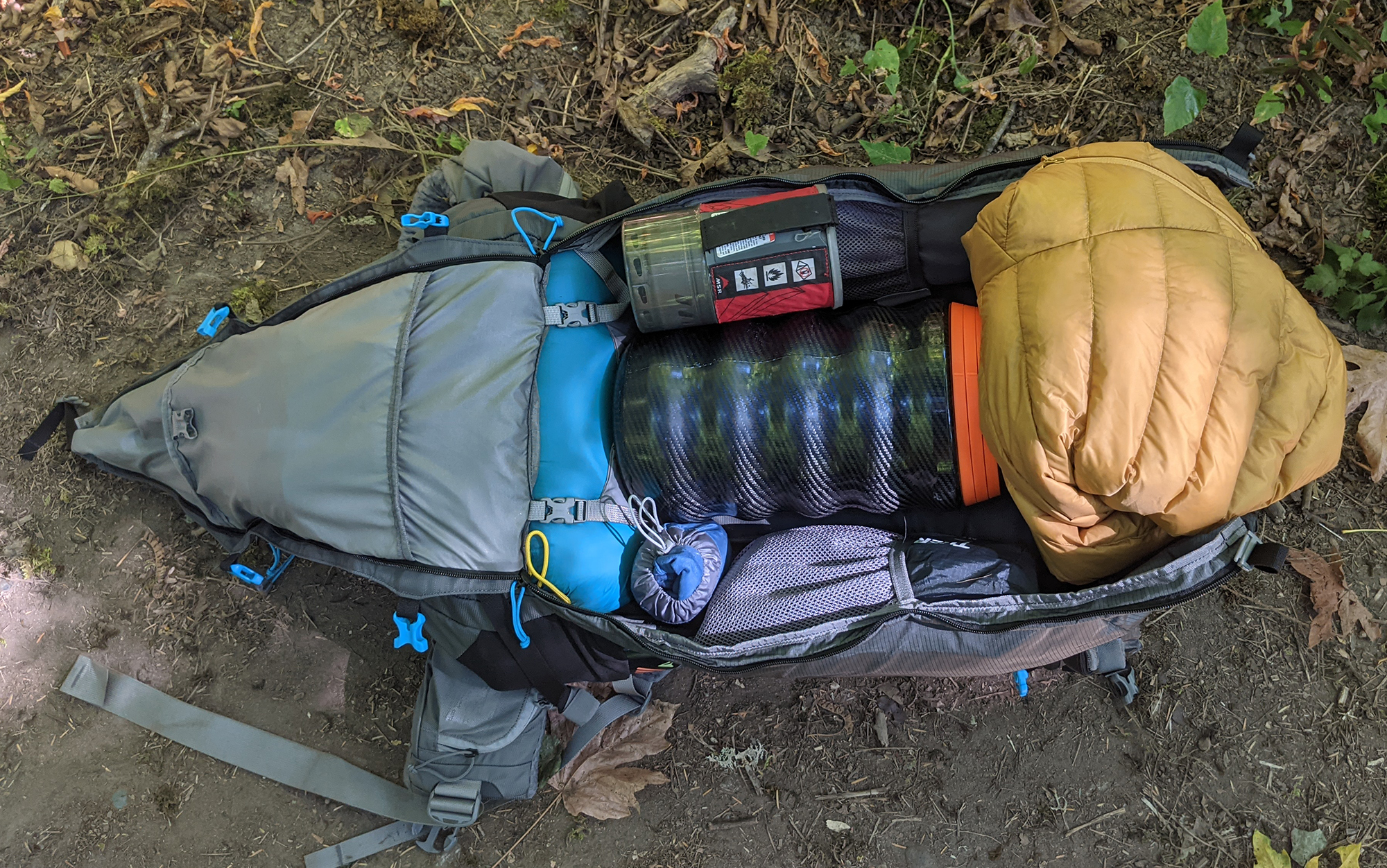
One set of pockets that didn’t impress our testers were the two side pockets. Multiple testers noted that they could only fit one item in each, such as a Nalgene or backpacking chair. However, if they wanted to pull out a bottle of water to drink from, they had to take off the backpack to access it. Further, they noted that the pockets were so shallow that if you didn’t tie items down in them, they were likely to fall out.
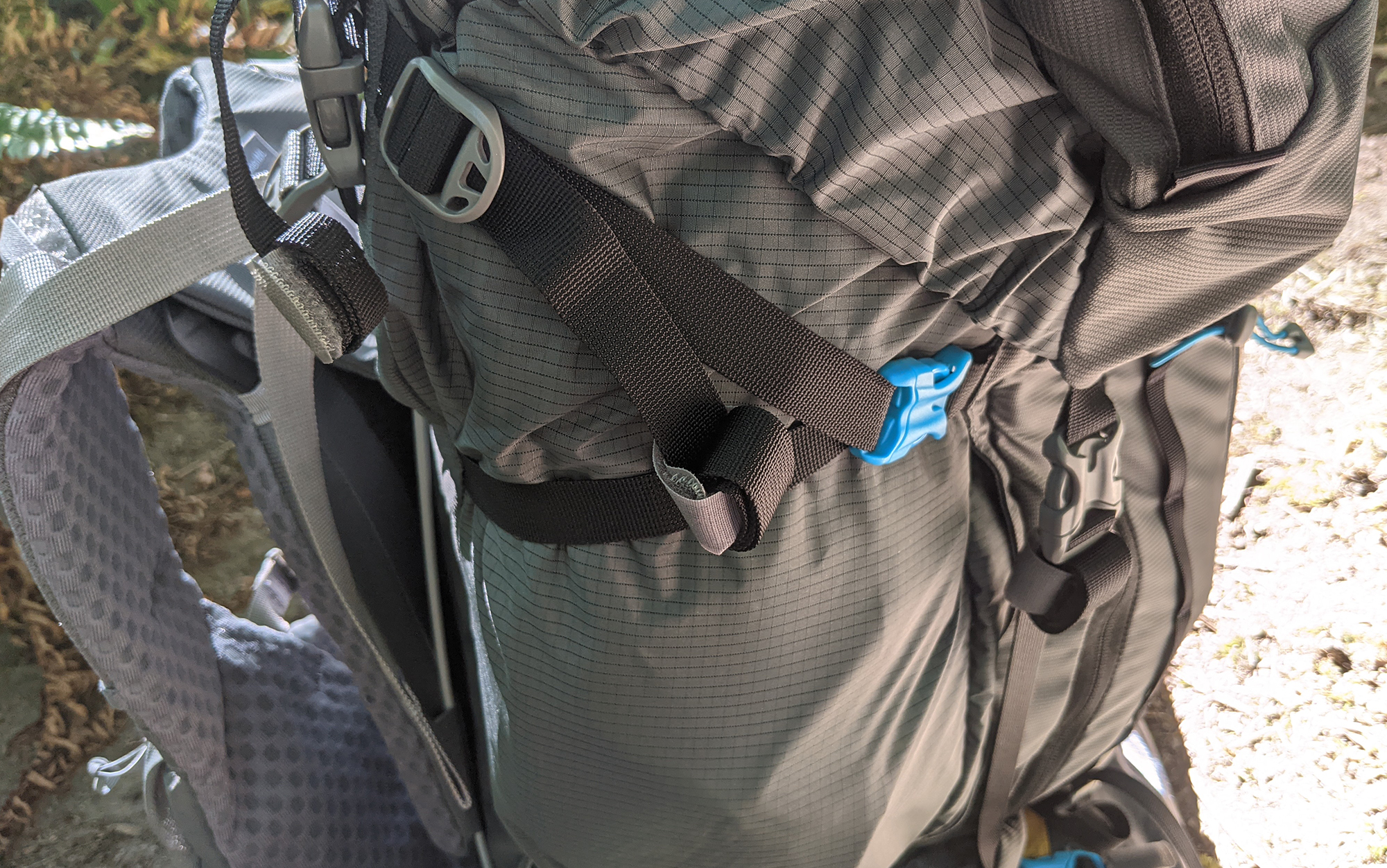
Our testers had mixed feelings about the velcro strap holders. Typically the excess nylon webbing at the end of any number of straps on a backpacking backpack simply hang loose, but the Bridger 65 has velcro straps at the end of each that can be used to tie up the excess. That contributes, along with the lack of a front mesh pocket, to a more streamlined aesthetic. However, Jason noted that there were no mesh tabs for the hip belt straps, where an excess of webbing was sometimes flapping and hitting his knees while hiking.

Unusually, the gear straps on the bottom of the Mystery Ranch Bridger 65—typically used to hold a tent—were quite short. While this caused one of our testers some frustration when trying to secure a tent to her pack, one benefit here is that backpackers will be less likely to strap a sleeping bag in this location—a common beginner’s mistake that can lead to a dirty or wet sleep system at the end of the day.
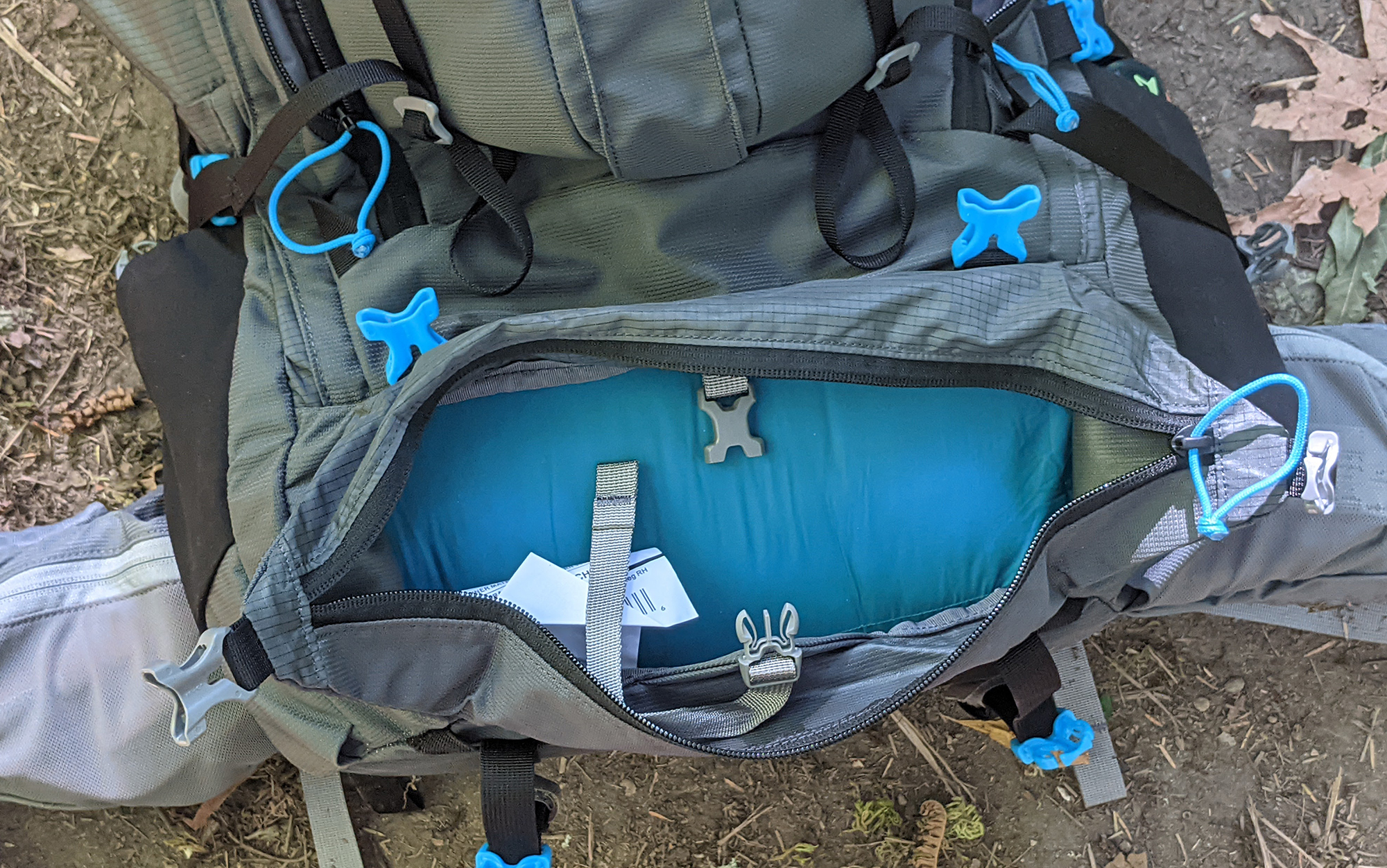
One feature of the Mystery Ranch Bridger 65 that testers agreed wasn’t working was the sleeping bag compartment. They found that, for their gear, it was simply too small. While a lightweight backpacker may be able to fit one of the best backpacking quilts in this compartment, it may not fit your current sleeping bag.
Final Thoughts on the Mystery Ranch Bridger 65
Rebecca’s Take: “Overall, I really liked the backpack. It was really comfortable with lots of functionality. It also felt like a solid backpack that would last and endure a lot of rough wear and tear from longer backpacking trips and mountaineering.”
Diana’s Take: “Every single inch of load seems to be adjustable on this thing and it is insanely comfortable. But there were a few issues with the details.”
Jason’s Take: “If I had to buy one pack this would probably be it because of the durability of the materials, but the downside is that this pack weighs six pounds. That being said, I think it will last forever and it seems to do a good job carrying a heavy load.”
There aren’t many true “forever” packs on the market. Over the course of their career, most backpackers will end up upgrading for several different reasons: Their backpack wore out and developed holes, their backpack simply wasn’t comfortable enough for longer trips, or they’ve decided to go ultralight. While the Mystery Ranch Bridger 65 is decisively not a lightweight option, backpackers that are committed to more traditional gear and heavier weights will find lots to love here—and a pack that they will be able to use indefinitely. Mystery Ranch has an exceptionally good warranty and repair program. For our testers, the heavy-duty fabric, customizable comfort, and great features like the shoulder strap pockets and inner mesh pockets more than made up for the small details we wished were different on this pack.
